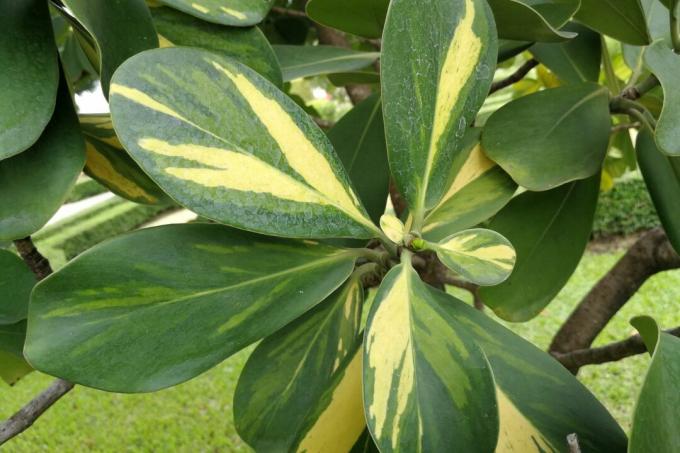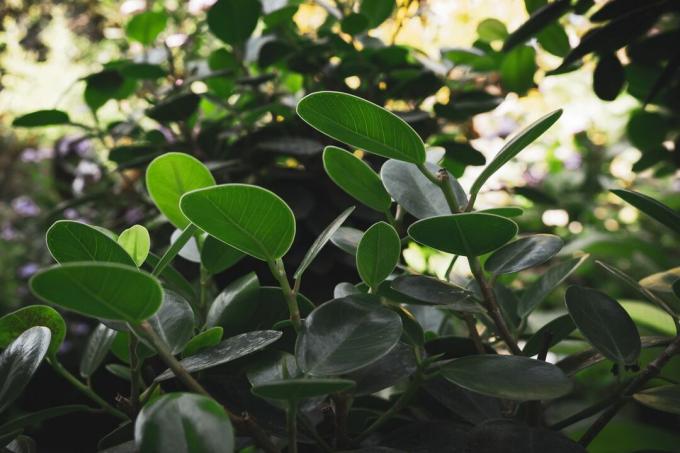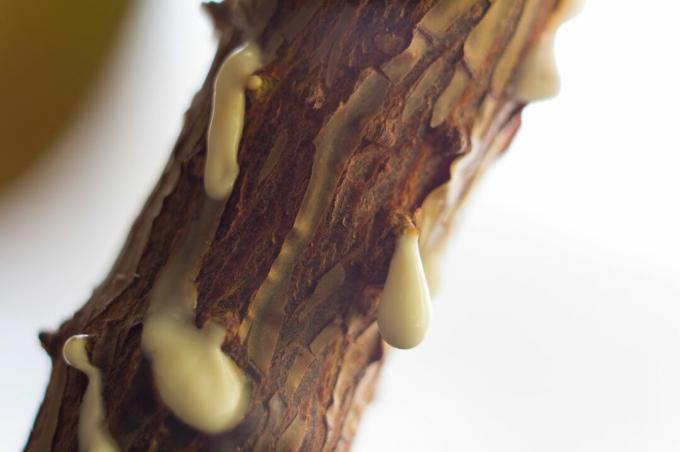Due to its leaves, the balsam apple is reminiscent of a rubber tree, but with ideal care it can also develop beautiful, pink-colored flowers. Here you can find out everything about the location, care and propagation of the balsam apple.

It doesn't take much to marvel at the balsam apple in your own home. Once you have a copy of your own and have chosen a suitable location, only occasional maintenance measures are necessary. Here you can find out what you have to pay attention to and how you can propagate your balsam apple yourself.
contents
- Balsam apple: flowering, origin and characteristics
- The most beautiful species and varieties
- Planting balsam apple: location, timing and procedure
-
Care of the balsam apple
- Cut balsam apple, pour and fertilize
- Brown dots on the balsam apple
- Balsam apple loses leaves
- Repot Clusia
- Propagate balsam apple
- Is the balsam apple poisonous?
Balsam apple: flowering, origin and characteristics
The balsam apple (Clusia) is a genus from the Clusicacea family. The term “balsam apple” is often synonymous with the species Clusia rosea and Clusia major used. The plant is also known under the names Rosen-Clusie and Autographenbaum. The succulent balsam apple is originally from the Caribbean and is also found in the tropics of South and Central America. It is an evergreen, hemiepiphytic plant - that is, the balsam apple begins its life in the canopy of other trees and over time develops roots towards the ground. In nature, the balsam apple becomes a shrub or tree up to 18 meters high, while in indoor cultivation it can reach a height of three meters under ideal conditions. Depending on the size of the pot and the pruning measures, the plant can also keep smaller dimensions.
The leaves of the Clusia are large, fleshy, and a rich green. They are reminiscent of some species of ficus, which is why the plant is also known as balsam fig. However, there is no close relationship here. If the balsam apple feels good, it forms decorative, white or pink flowers in summer, which smell of vanilla. A plant lamp can support flower formation. The small, apple-like fruits, on the other hand, are extremely rare in indoor plants, as both a female and a male plant must be present for fertilization. Both sexes of flowers give off a sweet-smelling juice that is supposed to attract insects for pollination. In the absence of insects, the flowers must be dusted by hand with a brush.
Why is the balsam apple also called the autograph tree? Since the leaves of the balsam apple are very thick and leathery, words can be scratched into them with pointed or sharp objects. It is also possible to leave an autograph on the leaves of the tree, which has given the plant the name “autograph tree” or “autograph tree”.

The most beautiful species and varieties
When one speaks of the balsam apple, the species is often Clusia rosea meant, although there are of course other types and varieties of balsam apple.
- Clusia Rosea'Princess': This variety is widely used as a houseplant. It has slightly smaller leaves than that Clusia rosea.
- Clusia major: Clusia major and Clusia rosea look very similar and are therefore usually viewed as one species. They differ slightly in the shape and color of the leaves.
- Clusia rosea ‘Variegata’: The leaves of this variety are variegated green and white and are a special eye-catcher.
- Clusia lanceolata: With its narrow, pointed leaves, this species looks a little different from its relatives. In terms of care, however, it does not differ.

Planting balsam apple: location, timing and procedure
The balsam apple is a rather undemanding plant and thrives without great care if it is in a suitable location.
Put the balsam apple in a light and warm place. The sapling cannot tolerate direct sunshine any more than shade, but sufficient brightness is important for healthy growth. The temperature should be around 20 ° C all year round and never drop below 15 ° C. If these temperatures are also reached outside in summer, you can place the balsam apple in a sheltered place on the balcony. Besides, she likes Clusia high humidity, which is typical for the tropical climate. Such air is achieved in the bathroom, for example, which must be bright enough for the balsam apple. Otherwise, you can regularly spray the plant with water or put a bowl of water on the heater in winter.

After purchasing the Clusia potted directly into a substrate that is optimally adapted to their needs. The soil should definitely be permeable, because the balsam apple needs sufficient moisture, but does not tolerate waterlogging. For this purpose, high-quality potting soil can be mixed with 30% sand. OurPlantura organic universal soil be used. This can store water and nutrients very well with the clay minerals it contains and gradually release them to the plant. The use of natural raw materials in the production of our earth also protects the environment. To support the drainage of water, a layer of potsherds or pebbles on the bottom of the pot is recommended.

Balsam apple in a glass:
It is also possible to keep the balsam apple in the glass, but a sure instinct is required here. Fungal infections can easily develop when the water level is too high or too low. It is therefore best to fill the glass with water until the fine roots of the balsam apple are covered, but the thicker roots are still in the air. Use lime-free water and change it once a week, cleaning the glass as well.
Care of the balsam apple
In addition to watering and fertilizing, balsam apple care also includes regular dusting of the large leaves. The maintenance measures are limited to the growing season between March and October.

Cut balsam apple, pour and fertilize
To water: To water the balsam apple, it is best to use soft, lime-free water such as rainwater. Stale tap water is also good. Check the substrate before watering: If soil adheres to the finger, the substrate is still moist enough. As soon as the surface dries, it should be watered. About 15 minutes after watering, the excess water should be poured out of the planter to prevent root rot. Loose leaves indicate an increased need for water.
Fertilize: During the growing season in summer, the balsam apple needs nutrients about once a month. It is best to use a high-quality liquid fertilizer, as this can be easily administered with the irrigation water for indoor plants. A sustainable option, for example, is our primarily organic one Plantura organic indoor & green plant fertilizerthat is perfectly tailored to the needs of ornamental foliage plants. The nutrients it contains sustainably supply the leaves and roots of your plants, and microorganisms ensure adequate growth promotion.
Cut: To stimulate branching, you can cut your young balsam apple - preferably in spring. The older your tree gets, the less it has to be cut. Remove dead leaves on a regular basis and later only make a cut to ensure that the balsam apple does not exceed the desired size.
Overwinter: The balsam apple needs warm temperatures all year round, which should not drop below 15 ° C. If the heating air is dry, a bowl of water near the plant can be used to increase the humidity.
tip: The large, green leaves should be cleaned of dust regularly with a damp cloth.
Brown dots on the balsam apple
If the balsam apple gets brown spots or yellow discoloration on the leaves, this is often the result of excessive exposure to the sun. Place the plant in a bright place without direct sun or protect the balsam apple at lunchtime, for example with a curtain.
Balsam apple loses leaves
If the balsam apple is too wet, the leaves may be shed. In this case, check the substrate and repot the plant in fresh and dry substrate. Water a little less than before and regularly monitor the moisture in the soil. It should only be poured when the substrate has slightly dried on the surface.

Repot Clusia
As with almost all plants, spring is the best time to repot the balsam apple. This should happen about every two to three years. First check whether the substrate is completely rooted. In this case, you should choose a slightly larger container and plant the balsam apple in a well-drained substrate. A layer of pottery ensures the necessary water drainage. If the root ball does not yet fill the vessel, it is sufficient to replace the upper substrate layer. When repotting, you can also mix a little storage fertilizer into the soil and thus do not have to worry about the nutrient supply of the balsam apple in the following year. For example, ours is suitable for this Plantura organic universal fertilizerwhich, as a complete fertilizer, contains all the important nutrients and can be used for many plants.
Propagate balsam apple
To propagate the balsam apple, it is best to use cuttings. To do this, simply cut off one or more shoots at an angle from the plant in spring with a sharp knife. These should have leaves, but no flower buds, and be at least 10 cm long.

Now there are two possibilities: The cutting can be placed directly in a water glass, whereby the root formation can be observed directly. The water should then be changed every few days. A plastic bag over the jar will increase the humidity and accelerate growth.
Alternatively, let the cutting edge of the cutting dry for about two days and then plant it in the growing medium - use ours for this, for example Plantura organic herb & seed compost, preferably mixed with a little sand. With its lower nutrient content, this ensures strong root growth at a young age, so that the small plants can also find support and grow splendidly in the future. Keep the substrate evenly moist without over-wetting it. Here, too, a plastic bag can accelerate growth.

tip: Individual leaves can also be used for propagation in the same way as shoots.
Is the balsam apple poisonous?
Since the balsam apple is poisonous - both for humans and for animals - it should not be consumed under any circumstances.
The rubber tree looks very similar to the balsam apple, even if there is no relationship. We show how to do that Rubber tree maintains, and give useful tips on location and propagation.


